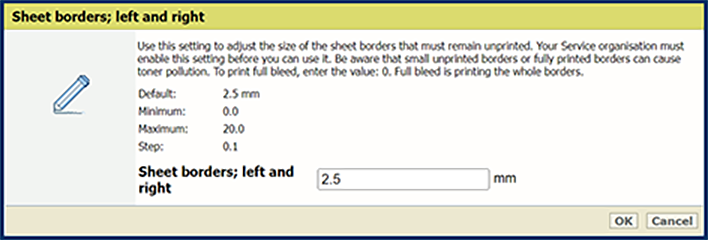

You can define print quality settings.
Be aware that the print quality settings affect all print jobs.
Open the Settings Editor and go to: .
 [System settings] tab
[System settings] tabGo to the [Print quality settings] section.
 [Print quality settings] section
[Print quality settings] sectionUse the [Edge enhancement for text] setting to improve the print quality of small text.
 [Edge enhancement for text] setting
[Edge enhancement for text] settingUse the [Edge enhancement for graphics] setting to improve the print quality of graphics.
 [Edge enhancement for graphics] setting
[Edge enhancement for graphics] settingUse the [Print sharpness] setting to increase or decrease the print sharpness.
 [Print sharpness] setting
[Print sharpness] settingUse the [Image compression optimisation] setting to give priority to image quality or productivity.
 [Image compression optimisation] setting
[Image compression optimisation] settingUse this setting to change the halftone screens that the printer uses. After changing this setting, the complete calibration procedure (shading correction, auto gradation adjustment and media family calibration) must be performed. Make sure that you use the matching output profiles in the media family.
Use the [Raster normal] setting to define the normal halftone screen.
 [Raster normal] setting
[Raster normal] settingUse the [Raster fine] setting to change the fine halftone screen.
 [Raster fine] setting
[Raster fine] settingClick [OK].
Calibrate the printer and default media families.
Use the [Stroke width adjustment] setting to indicate for which colours you want thicker lines.
[Only for the color black]
[For all colors]
 [Stroke width adjustment] setting
[Stroke width adjustment] settingUse the [Width adjustment in horizontal direction] setting to indicate the width adjustment of characters and lines in horizontal direction.
 [Width adjustment in horizontal direction] setting
[Width adjustment in horizontal direction] settingUse the [Width adjustment in vertical direction] setting to indicate the width adjustment of characters and lines in vertical direction.
 [Width adjustment in vertical direction] setting
[Width adjustment in vertical direction] settingUse the [Condition for stroke width adjustment] setting to indicate if you want thicker characters and lines for all jobs or for 1200 dpi jobs only.
 [Condition for stroke width adjustment] setting
[Condition for stroke width adjustment] settingClick [OK].
Use the [Sheet border; left and right] and [Sheet border; top and bottom] settings to adjust the size of the sheet borders that must remain unprinted. Your Service organization must enable this setting before you can use it.
Be aware that small unprinted borders or fully printed borders can cause toner pollution. To print full bleed, enter the value 0. Full bleed is printing the whole borders.
 [Sheet border; left and right] setting
[Sheet border; left and right] setting